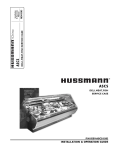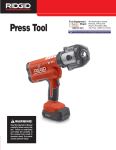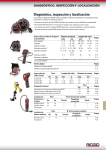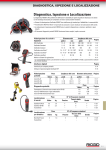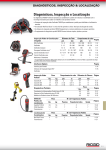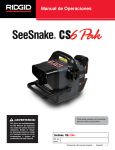Download RIDGID 1822-I Operator`s manual
Transcript
microDrain™ System Manual SeeSnake microDrain Inspection System ® ™ WARNING! Read this Operator’s Manual carefully before using this tool. Failure to understand and follow the contents of this manual may result in electrical shock, fire and/or serious personal injury. 99 Washington Street Melrose, MA 02176 Phone 781-665-1400 Toll Free 1-800-517-8431 Visit us at www.TestEquipmentDepot.com SeeSnake® microDrain™ Inspection System Table of Contents Recording Form for Machine Serial Number ..............................................................................................................1 Safety Symbols..............................................................................................................................................................2 General Safety Information Work Area Safety........................................................................................................................................................2 Electrical Safety ..........................................................................................................................................................2 Personal Safety ..........................................................................................................................................................2 Equipment Use and Care............................................................................................................................................2 Service ........................................................................................................................................................................3 Specific Safety Information ..........................................................................................................................................3 SeeSnake microDrain Inspection System Product Safety ..........................................................................................3 Description, Specifications and Standard Equipment Description ..................................................................................................................................................................4 Specifications..............................................................................................................................................................4 Standard Equipment ..................................................................................................................................................4 Icon Legend ................................................................................................................................................................4 microDrain System Components ................................................................................................................................5 Assembly Camera Head Routing ................................................................................................................................................5 Installing System Cable ..............................................................................................................................................6 Reversing/Installing The Display Cradle (microEXPLORER Camera Monitor) ..........................................................6 Connecting microEXPLORER Camera Monitor to microDrain System ......................................................................7 microDrain System Ball Guides ..................................................................................................................................7 Installing Ball Guides ..................................................................................................................................................7 Pre-Operation Inspection ............................................................................................................................................8 Work Area and Equipment Set Up ..............................................................................................................................8 Setting Up The microDrain System ............................................................................................................................8 Operating Instructions..................................................................................................................................................9 Locating The microDrain System Sonde ..................................................................................................................11 Retrieving The Camera ............................................................................................................................................12 Using Guide Tubes......................................................................................................................................................12 Cleaning Instructions..................................................................................................................................................13 Accessories ................................................................................................................................................................13 Transport and Storage................................................................................................................................................13 Service and Repair ......................................................................................................................................................13 Disposal ......................................................................................................................................................................13 Troubleshooting ..........................................................................................................................................................14 Lifetime Warranty ........................................................................................................................................Back Cover ii Test Equipment Depot - 800.517.8431 - 99 Washington Street Melrose, MA 02176 TestEquipmentDepot.com SeeSnake® microDrain™ Inspection System SeeSnake® microDrain™ Record Serial Number below and retain product serial number which is located on nameplate. Serial No. Test Equipment Depot - 800.517.8431 - 99 Washington Street Melrose, MA 02176 - TestEquipmentDepot.com SeeSnake® microDrain™ Inspection System Safety Symbols In this operator’s manual and on the product, safety symbols and signal words are used to communicate important safety information. This section is provided to improve understanding of these signal words and symbols. This is the safety alert symbol. It is used to alert you to potential personal injury hazards. Obey all safety messages that follow this symbol to avoid possible injury or death. DANGER DANGER indicates a hazardous situation which, if not avoided, will result in death or serious injury. WARNING WARNING indicates a hazardous situation which, if not avoided, could result in death or serious injury. CAUTION CAUTION indicates a hazardous situation which, if not avoided, could result in minor or moderate injury. NOTICE NOTICE indicates information that relates to the protection of property. This symbol means read the operator’s manual carefully before using the equipment. The operator’s manual contains important information on the safe and proper operation of the equipment. This symbol means always wear safety glasses with side shields or goggles when handling or using this equipment to reduce the risk of eye injury. This symbol indicates the risk of electrical shock. General Safety Rules WARNING Read all safety warnings and instructions. Failure to follow the warnings and instructions may result in electric shock, fire and/or serious injury. SAVE THESE INSTRUCTIONS! Work Area • Keep work area clean and well lit. Cluttered or dark areas invite accidents. • Do not operate equipment in explosive atmospheres, such as in the presence of flammable liquids, gases, or dust. Equipment can create sparks which may ignite the dust or fumes. • Keep children and by-standers away while operating equipment. Distractions can cause you to lose control. Electrical Safety • Avoid body contact with earthed or grounded surfaces such as pipes, radiators, ranges and refrigerators. There is an increased risk of electrical shock if your body is earthed or grounded. • Do not expose equipment to rain or wet conditions. Water entering equipment will increase the risk of electrical shock. • Do not abuse the cord. Never use the cord for carrying, pulling or unplugging the equipment. Keep cord away from heat, oil, sharp edges or 2 moving parts. Damaged or entangled cords increase the risk of electric shock. • If operating equipment in a damp location is unavoidable, use a ground fault circuit interrupter (GFCI) protected supply. Use of a GFCI reduces the risk of electric shock. • Keep all electrical connections dry and off the ground. Do not touch equipment or plugs with wet hands. This reduces the risk of electrical shock. Personal Safety • Stay alert, watch what you are doing and use common sense when operating equipment. Do not use equipment while you are tired or under the influence of drugs, alcohol or medication. A moment of inattention while operating equipment may result in serious personal injury. • Use personal protective equipment. Always wear eye protection. Protective equipment such as dust mask, non-skid safety shoes, hard hat, or hearing protection used for appropriate conditions will reduce personal injuries. • Do not overreach. Keep proper footing and balance at all times. This enables better control of the equipment in unexpected situations. Equipment Use and Care • Do not force equipment. Use the correct equipment for your application. The correct equipment will Test Equipment Depot - 800.517.8431 - 99 Washington Street Melrose, MA 02176 TestEquipmentDepot.com SeeSnake® microDrain™ Inspection System do the job better and safer at the rate for which it is designed. • Do not use equipment if the switch does not turn it ON and OFF. Any equipment that cannot be controlled with the switch is dangerous and must be repaired. • Disconnect the plug from the power source and/or the battery pack from the equipment before making any adjustments, changing accessories, or storing. Such preventive safety measures reduce the risk of injury. • Store idle equipment out of the reach of children and do not allow persons unfamiliar with the equipment or these instructions to operate the equipment. Equipment can be dangerous in the hands of untrained users. • Maintain equipment. Check for misalignment or binding of moving parts, missing parts, breakage of parts and any other condition that may affect the equipment’s operation. If damaged, have the equipment repaired before use. Many accidents are caused by poorly maintained equipment. • Use the equipment and accessories in accordance with these instructions, taking into account the working conditions and the work to be performed. Use of the equipment for operations different from those intended could result in a hazardous situation. • Use only accessories that are recommended by the manufacturer for your equipment. Accessories that may be suitable for one piece of equipment may become hazardous when used with other equipment. • Keep handles dry and clean; free from oil and grease. Allows for better control of the equipment. Service • Have your equipment serviced by a qualified repair person using only identical replacement parts. This will ensure that the safety of the equipment is maintained. SAVE THESE INSTRUCTIONS! Keep this manual with the equipment for use by the operator. SeeSnake microDrain Inspection System Product Safety • An improperly grounded electrical outlet can cause electrical shock and or severely damage equipment. Always check work area for a properly grounded electrical outlet. Presence of a three prong or GFCI outlet does not insure that the outlet is properly grounded. If in doubt, have the outlet inspected by a licensed electrician. • Do not operate this equipment if operator or machine is standing in water. Operating machine while in water increases the risk of electrical shock. • The microDrain System camera and pushrod are waterproof. The monitor and other electrical equipment and connections are not. Do not expose the equipment to water or rain. This increases the risk of electrical shock. • Do not use where a danger of high voltage contact is present. The equipment is not designed to provide high voltage protection and isolation. • Read and understand this operator’s manual, the monitor operators’ manual, and the instructions for any other equipment in use before operating the microDrain System. Failure to follow all instruction may result in property damage and/or serious personal injury. • Always use appropriate personal protective equipment while handling and using equipment in drains. Drains may contain chemicals, bacteria and other substances that may be toxic, infectious, cause burns or other issues. Appropriate personal protective equipment always includes safety glasses, and may include equipment such as drain cleaning gloves or mitts, latex or rubber gloves, face shields, goggles, protective clothing, respirators and steel toed footwear. • If using drain cleaning equipment at the same time as using drain inspection equipment, only wear Specific Safety Information WARNING This section contains important safety information that is specific to this equipment. Read these precautions carefully before using the SeeSnake® microDrain™ Inspection System to reduce the risk of electrical shock, fire or other serious personal injury. Ridge Tool Company 3 SeeSnake® microDrain™ Inspection System RIDGID Drain Cleaning Gloves. Never grasp the rotating drain cleaning cable with anything else, including other gloves or a rag. They can become wrapped around the cable, causing hand injuries. Only wear latex or rubber gloves under RIDGID Drain Cleaner Gloves. Do not use damaged drain cleaning gloves. • Practice good hygiene. Use hot, soapy water to wash hands and other exposed body parts exposed to drain contents after handling or using drain inspection equipment. Do not eat or smoke while operating or handling drain inspection equipment. This will help prevent contamination with toxic or infectious material. Dimensions: Length .........................13.25" (33.6 cm) Depth...........................6.6 " (16.7 cm) Height ..........................14.2" (36 cm) (without microEXPLORER Camera Monitor Cradle) Line Capacity.................11⁄4" to 3" (3.2 to 7.6 cm) Maximum Run ...............30' (9.14 m) Sonde Transmitter.........Optional 512Hz Reel & Frame Diameter........................12.75" (32 cm) Camera Diameter ..........0.87" (22 mm) Description, Specifications And Standard Equipment Camera Length..............0.87" (22 mm) Push Cable Diameter ....0.33" (8.3 mm) Description Video .............................510 x 496 The SeeSnake® microDrain™ Inspection System is a portable pipe inspection diagnostic reel and camera specifically for small pipes and conduits. It provides a unique removable pushrod drum, for convenience in cleaning or replacing pushrods. It also has a removable system cable, enabling the microDrain System to be configured for use with any SeeSnake camera control unit (CCU), or for use with the lightweight hand-held microEXPLORER™ Digital Inspection Camera monitor. Number Of Pixels ..........250 The microDrain Reel uses an advanced pushrod design and a proprietary small-radius camera design which allows camera inspection through very small diameter pipes, Ptraps and very small-radius bends which conventional inspection systems often cannot inspect. The microDrain System is protected under pending U.S. and International patent applications. When using the microDrain Reel with an appropriate SeeSnake control unit, the operator can connect an external line transmitter and use a pipe cable locator to linetrace the path of the microDrain System pushrod in a pipe. NOTICE Use of the microDrain camera in porcelain appliances will cause scratching to the surface finish of the appliances. To avoid scratching a toilet, for example, use a curved non marking pipe segment to lead the camera past the porcelain bowl and into the drain. Lighting..........................3 Luxeon LEDs Operating Environment: Temperature................32° to 115° F (5°C to 46°C) Humidity ......................5% to 95% Storage Temperature....-4°F to 158°F (-20°C to 70°C) Waterproof Depth ........266' (81 m) Standard Equipment • Operator’s Manual • Instructional DVD • Ball Guides Icon Legend Slip-Ring Unlock Position Specifications Weight ...........................8.9 lbs (4 kg) (with microEXPLORER Camera Monitor), 7 lbs. (3.2 Kg) (without microEXPLORER Camera Monitor) 4 Ridge Tool Company Slip-Ring Lock Position SeeSnake® microDrain™ Inspection System microDrain System Components System Cable for SeeSnake CCU Shoulder Strap Camera Head Case Latch Case Latch Case Latch Pushrod Guide Rear Case Camera Clip Camera Head Front Case Removable Pushrod Drum Pushrod Figure 3 – Inside Case Feet Assembly Figure 1 – Front View (SeeSnake Configuration) WARNING To reduce the risk of serious injury during use, follow these procedures for proper assembly. microEXPLORER Camera Monitor microEXPLORER Camera Monitor Cradle System Cable for MicroEXPLORER Camera Monitor Camera Head Routing 1. Set the unit on a level surface. microEXPLORER Camera Monitor Connector Plug 2. Unfasten the case latches on either side of the microDrain Reel (Figure 4). Cord Wrap Case Latch Rear Case Figure 4 – Unlatching the microDrain Reel Case Slip Ring Module Feet Figure 2 – Rear View (microEXPLORER Camera Monitor Configuration) 3. Open the front case and locate camera head in the pushrod drum. 4. Route the camera head out through the pushrod guide in the front of the case and secure it in the provided clip (Figures 5 and 6). 5. Close and re-latch the case. Ridge Tool Company 5 SeeSnake® microDrain™ Inspection System If the system cable slip-ring module is not installed, squarely insert the slip-ring module into the hub and twist it clockwise until it locks into position. (See Figure 8.) If changing system cable, twist slip ring module counter clockwise to unlock and squarely retract. Install new cable as shown previously. Unlocked Figure 5 – Routing The Camera Head Slip Ring Module Cover Locked Figure 8 – Locking The Slip Ring Module Cover Reversing/Installing The Display Cradle (microEXPLORER Camera Monitor) If you are using the microDrain Reel with the microEXPLORER Camera monitor unit, you may find it more convenient to have the microEXPLORER Camera monitor facing the other way when it is seated in its cradle. To reverse the orientation of the cradle, do the following: Figure 6 – Camera Head Properly Routed Installing System Cable NOTICE Do NOT touch the contact pins in the slip-ring module. This can cause the contact pins to break. 1. Remove the microEXPLORER Camera monitor from the cradle. With a Philips head screwdriver, remove four screws holding the cord wrap arms and cradle to the case. Remove the cord wrap arms and the screws (Figure 9). Cradle The contact pins will not break under normal use, correctly connected. However pressing side ways on them can cause them to break, as shown in Figure 7. Screwhead Cord Wrap Arm Broken Contact Pin Figure 9 – Cradle Support and Cord-Wrap Arms Figure 7 – Broken Contact Pin 6 2. Use one of the screws to remove the nuts from the back side of the cradle. The nuts are friction-fitted into the holes on the opposite side of the cradle from the cord-wrap arms. By inserting a screw from the back Test Equipment Depot - 800.517.8431 - 99 Washington Street Melrose, MA 02176 TestEquipmentDepot.com SeeSnake® microDrain™ Inspection System and threading it two or three turns into the nut, you can pull the nut out. 3. Without taking the nut off the screw, insert the nut into the hole on the opposite side of the cradle from which the screw was removed. Firmly seat the nut into the friction-fit at the bottom of the hole. 4. Unthread the screw. Repeat for each of the remaining three nuts. 5. Position the cord-wrap arm and cradle on the rear of the case, facing in the opposite direction. Make sure the cord-wrap horns point outward. 6. Start each screw into its nut by hand. Tighten the screws with the screwdriver. 7. Replace the display unit in the cradle. Use a similar process for installing the display cradle. Connecting microEXPLORER Camera Monitor to microDrain System reduce wear and tear on the camera system. If you run into difficulty moving the camera head through a particular pipe, the centering guides can be easily removed. The placement of the guides can be adjusted along the length of the camera head to best suit the job. For example, you may find that placing two centering guides near the front end of the camera may bias the camera head upward. This could be beneficial if you need to see the top of the pipe during your inspection. Ball guides can also help negotiate some passages, such as those shown on page 11. Installing Ball Guides The ball guides supplied with the microDrain System are designed to slip easily onto the camera spring and lock into place. The ball guide has two red sliding locks and two blue latches. 1. Slide the red slide locks away from the blue latches on both sides of the guide (Figure 11). Latch Tab In (Closed) Align the microEXPLORER Camera Connector Plug with the plug on the microEXPLORER Camera and slide straight in, seating it squarely. The curved face of the connector plug on the system cable faces upward, sliding under the forward edge of the microEXPLORER Camera monitor when fully seated (See Figure 10). Latch Tab Out (Open) Blue Latches Tab NOTICE Do not twist the connector plug to prevent damage to the plug. Shoulder Red Slide Lock UNLOCKED/UNLATCHED LOCKED/LATCHED Figure 11 – Ball Guide Installation 2. Press the small tabs on the blue latches so they click outward (away from each other). 3. Slide the ball guide into desired position over the camera head. Figure 10 – Connecting the microEXPLORER Camera Monitor 4. Press down on the shoulders of the blue latches so the latches are pressed in toward each other, and engage into the spring. microDrain System Ball Guides 5. Slide the two red sliding locks back over their respective blue latches so they cannot pop out in use. Ball Guide Ball guides are designed to help center the camera in pipes of various sizes, and keep the camera clear of bottom sludge in the pipe. By bringing the camera head closer to the center of the pipe they improve picture quality, allowing the camera to see equally in all directions and help keep the camera lens clear during inspections (Figure 12). Ball guides should be used when possible, because they Camera Spring Figure 12 – Ball Guide In Use Ridge Tool Company 7 SeeSnake® microDrain™ Inspection System Pre-Operation Inspection WARNING Before each use, inspect your microDrain System camera and reel and correct any problems to reduce the risk of serious injury from electrical shock or other causes and prevent machine damage. 1. Confirm that the power is off and if used with a camera control unit (CCU) other than the MicroEXPLORER Camera monitor confirm that the CCU is not connected to the unit. Inspect the system cable and connectors for damage or modification. 2. Clean any dirt, oil or other contamination from the microDrain System to aid in inspection and to prevent the unit from slipping from your grip while transporting or using. 3. Inspect the microDrain System for any broken, worn, missing, misaligned or binding parts, or any other condition which might prevent safe, normal operation. Confirm that the unit is properly assembled. Make sure that the drum turns freely. Inspect the pushrod for any cuts, breaks, kinks or ruptures. 4. Inspect any other equipment being used per its instructions to make sure it is in good usable condition. 5. If any problems are found, do not use the unit until the problems are corrected. Work Area and Equipment Set Up 2. Inspect the work to be done If possible, determine the drain access point(s), size(s) and length(s), presence of drain cleaning chemicals or other chemicals, etc. If chemicals are present, it is important to understand the specific safety measures required to work around those chemicals. Contact the chemical manufacturer for required information. If needed, remove fixture (water closet, sink, etc.) to allow access. 3. Determine the correct equipment for the application. The microDrain System is made for: • 11/4" to 3" lines up to 30' long. • Inspection equipment for other applications can be found by consulting the Ridge Tool Catalog. 4. Make sure all equipment has been properly inspected. 5. Evaluate the work area and determine if any barriers are needed to keep bystanders away. Bystanders can distract the operator during use. If working near traffic, erect cones or other barriers to alert drivers. Setting Up The microDrain System WARNING Connections If using the microDrain Reel with a microEXPLORER Camera monitor, no additional connections beyond those described in the assembly section are needed when setting up the unit for an inspection. Set up the microDrain System and work area according to these procedures to reduce the risk of injury from electrical shock, fire, and other causes, and to prevent damage to the microDrain System. Always wear eye protection to protect your eyes against dirt and other foreign objects. 8 1. Check work area for: • Adequate lighting. • Flammable liquids, vapors or dust that may ignite. If present, do not work in area until sources have been identified and corrected. The microDrain System is not explosion proof. Electrical connections can cause sparks. • Clear, level, stable dry place for machine and operator. Do not use the machine while standing in water. If needed, remove the water from the work area. • Clear path to electrical outlet, if used for monitor, that does not contain any potential sources of damage for the power cord. When using with SeeSnake camera control units (CCU’s), unwrap the system cable from the cord wrap on the microDrain Reel case. Attach the system cable connector to the matching connector on the CCU. Align the guide pin on the cable connector with the guide socket in the CCU connector and push the cable connector straight in. A ridge molded into the outside of the cable connector will point up when the guides are properly aligned. Tighten the Ridge Tool Company SeeSnake® microDrain™ Inspection System outer locking sleeve on the cable connector to retain the system cable in place. Do not twist the cable while tightening the locking sleeve. This can damage the cable. See Figure 13 and 14. 2. Set the microDrain Reel approximately six feet (two meters) from the entry point. This provides ample pushrod for grasping and manipulating without excess dragging on the ground. When properly located, push cable will only come off the reel when you pull it. Preferably, lay the microDrain Reel on its back with the camera unit and pushrod on top. There are foot pads provided on the cord wrap to allow placement in this position. This position provides the greatest stability and helps to prevent tipping of the reel during use. Operating Instructions WARNING Figure 13 – Connecting To A SeeSnake CCU Always wear eye protection to protect your eyes against dirt and other foreign objects. When inspecting drains that might contain hazardous chemicals or bacteria, wear appropriate protective equipment, such as latex gloves, goggles, face shields or respirators, to prevent burns and infections. Do not operate this equipment if operator or machine is standing in water. Operating machine while in water increases the risk of electrical shock. Rubber soled, non-slip shoes can help prevent slipping and electric shock, especially on wet surfaces. Figure 14 – microDrain System Connected to SeeSnake® MINIPak Monitor CCU Follow operating instructions to reduce the risk of injury from electrical shock and other causes. If using a microDrain System set up for use with a microEXPLORER Camera monitor, it can be converted for use with other SeeSnake CCU’s (or vice versa) by changing the system cable as detailed in the assembly section. Set up the microEXPLORER Camera monitor or CCU as per its instructions. If using the microEXPLORER Camera monitor or a battery powered CCU, make sure that the required batteries are fully charged and installed. Placement 1. Place the microEXPLORER Camera monitor or CCU monitor to allow easy viewing while manipulating the pushrod and camera. Usually right next to the entry point for the pushrod is a good choice. The location should not be wet or allow the monitor unit to get wet during use. 1. Make sure all equipment is properly set up. 2. Pull several feet of pushrod from the reel. Make sure the camera window is clean. In some cases, a slight film of detergent on the window may minimize debris sticking to the window. Place the camera unit into the line to be inspected. NOTICE If running the camera through a porcelain fixture (such as a toilet) or in an inlet with sharp edges that could damage the pushrod, you may want to use a guide made of PVC or other non marking pipe to prevent damage to the fixture or the pushrod. See section “Using Guide Tubes”: 3. Turn the CCU on. As per the specific CCU operator manual, adjust the camera head LED lighting brightness and the display image. As the pipe material and other factors vary, it may be necessary to make Ridge Tool Company 9 SeeSnake® microDrain™ Inspection System adjustments as the drain is being inspected. For instance, white PVC pipe requires less light than black PVC. Slight adjustments in lighting brightness can be used to highlight issues discovered during an inspection. Always use the least amount of lighting to maximize picture quality and reduce heat build up. Lowering the LED brightness setting to minimum activates the built-in Sonde. In models which do not have a Sonde, the power usually directed to the Sonde will be output to the LEDs instead, and make them switch to high brightness from their lowest setting. This behavior is normal. 4. If recording the inspection, follow the instructions in the specific CCU Operator’s manual. 5. If possible, run water through the system during the inspection. This helps to keep the system clean and makes pushing the pushrod easier. It also helps to orient the image to the bottom of the pipe. This can be done by placing a hose down the line or turning on a fixture/flushing a toilet. The flow can be shut off as needed for viewing. 6. Grip the pushrod and carefully start to feed it into the drain to be inspected. It is recommended that rubber gripper type gloves be used to manipulate the pushrod. They improve grip and help to keep hands clean. NOTICE Use of the microDrain camera in porcelain appliances will cause scratching to the surface finish of the appliances. To avoid scratching a toilet, for example, use a curved non marking pipe segment to lead the camera past the porcelain bowl and into the drain. See Using Guide tubes on page 12. Figure 16 – Up Close When pushing the pushrod in to the line, keep the pushrod clear of any sharp edges on the inlet that could cut, grab or damage the pushrod Grasp and push short sections of pushrod at a time and keep your hands near the inlet to better control the pushrod and prevent it from folding over, snapping, cutting the pushrod jacket or other damage. Cutting the pushrod jacket could increase the risk of electrical shock. As the pushrod is fed into the line, watch the monitor to know what is coming. When the lights are set at less than maximum setting, it may help to occasionally turn the brightness up to see what is coming further down the line. Be aware of obstructions (such as crushed pipe) or excessive hard build up in the line that could prevent retrieval of the camera. Do not try to use the camera head to clear obstructions. The microDrain System is a diagnostic tool, not a drain cleaner. Using the camera head to clear obstructions could damage the camera head or cause it to be caught in the obstruction, preventing removal (Figure 17). Figure 17 – Encountering An Obstruction – Do Not Use Camera Head To Clear Obstructions Figure 15 – Doing An Inspection 10 Most of the time a slow steady push through the system works the best. At changes in direction such as P-traps, Tee’s, Y’s, elbows, etc., it may be necessary to use a quick push to “pop” the camera head around the bend. This is done by pulling the camera head back from the bend approximately 8" (20 cm) and giving it a quick thrust through the bend. Be as gentle as possible, and use no more force than required to do this. Excessive force can damage the camera head. Do not hammer or snap the Test Equipment Depot - 800.517.8431 - 99 Washington Street Melrose, MA 02176 TestEquipmentDepot.com SeeSnake® microDrain™ Inspection System camera through bends. Do not force the camera head through if there is a large amount of resistance. Be especially careful through Tee’s, as the pushrod could fold over in the Tee and make retrieval difficult or impossible. Watch to make sure that the drum does not hang up during use. If the drum hangs up and the pushrod continues to be pulled from the reel, the pushrod will tighten around the hub of the drum and cause the pushrod to jam in the drum and stress the pushrod. Drain Inlet Figure 20 – Camera Head Blocked in Turn Pushrod Figure 18 – Avoid Pulling At Sharp Angles When inspecting the line, moving the camera head past the area to be inspected and slowly pulling it back may give better results. Usually pulling the camera head back allows for more controlled and consistent viewing. When pulling the pushrod, keep clear of any sharp edges and do not pull at sharp angles to the inlet to prevent damage to the pushrod (Figure 18). If needed, jiggle the camera head in any standing water to rinse any debris from the camera window. Depending on what is encountered during the inspection, it may help to add, remove or change the position of ball guides on the camera head. Ball guides may be able direct the camera towards a section of the line (such as the top), raise the camera head out of the liquid in the pipe, or help negotiate bends. This is especially so at tight turns such as in a toilet flange (See Figures 19-22). See the Assembly Section for information on ball guide attachment. Figure 21 – Camera Head with Ball Guide in Turn Ball Guide Camera Figure 22 – Successful Passage Spring Figure 19 – Ball Guide In Use Locating The microDrain System Sonde Some microDrain System units are equipped with a Sonde (In Line Transmitter) just behind the camera head. If equipped with a Sonde, a locating unit can be used to detect the Sonde and locate features in the drain being inspected. Ridge Tool Company 11 SeeSnake® microDrain™ Inspection System Controlling the Sonde from a SeeSnake CCU is described in the Operator's Manual for the CCU and depends on the model being used. Typically, the Sonde can be turned on and off from the CCU. If you are using the microDrain System with the microEXPLORER Camera hand-held monitor, the Sonde is activated by turning the LED brightness control down to zero. Once the Sonde has been located, the LEDs can be returned to their normal brightness level to continue the inspection. When the microDrain System Sonde is turned on, a locator such as the RIDGID SR-20, SR-60, Scout, or NaviTrack® II set to 512 Hz will be able to detect it. The most workable approach to tracking the Sonde is to run the pushrod into the pipe about five or ten feet (1.5 to 3 meters) and use the locator to find the Sonde's position. If desired, you can then extend the pushrod a similar distance further down-pipe and locate the Sonde again starting from the previous located position. To locate the Sonde, turn the locator on and set it to Sonde mode. Scan in the direction of the Sonde's probable location until the locator detects the Sonde. Once you have detected the Sonde, use the locator indications to zero in on its location precisely. For detailed instructions on Sonde locating, consult the Operator's Manual for the locator model you are using. Figure 23 – Guide Tubes The PVC tube guide is fabricated from sections of PVC pipe and conduit so it has a curved access tube at the bottom which guides the pushrod and cable past the scratchable surface of the toilet (Figure 24). Retrieving The Camera Once the inspection has been completed, pull the pushrod back with slow, steady force. Continue running water down the line if possible to help clean the pushrod. A towel can be used to wipe off the pushrod as it is withdrawn. Pay attention to the force required to withdraw the pushrod. The pushrod may get hung up while being retrieved, and may need to be manipulated as done during insertion. Do not force the pushrod or exert excessive force. This could damage the camera or pushrod. When pulling the pushrod, keep clear of any sharp edges and do not pull at sharp angles to the inlet to prevent damage to the pushrod. Figure 24 – Using A PVC Guide Tube The flexible guide tube is fashioned from ribbed flexible conduit, and is used in a similar fashion (Figure 25). As the pushrod is withdrawn from the inlet, feed it back into the drum. Using Guide Tubes To avoid marring or scratching toilet bowls or other porcelain surfaces or to avoid sharp edges at the inlet you may find it valuable to have a guide piece fabricated from PVC or flexible tubing. Two possible types of guide tube are shown below in Figure 23. 12 Figure 25 – Using The Flexible Guide Tube Ridge Tool Company SeeSnake® microDrain™ Inspection System Cleaning Instructions Transport and Storage WARNING Make sure that the system cable is disconnected from the CCU prior to cleaning to reduce the risk of electrical shock. Clean the microEXPLORER Camera monitor or CCU as per its operators manual. Prior to cleaning the microDrain, remove the microEXPLORER Camera monitor from the display cradle. Do not allow the microEXPLORER Camera monitor or CCU to get wet during cleaning. The microDrain System can be cleaned by wiping with a soft, damp cloth. Do not use any solvents to clean the microDrain System. They can damage the unit. If desired, a disinfectant can be used on the microDrain System. The drum and cable may be removed and the interior of the drum cleaned with a hose or pressure wash. The outside of the drum can be cleaned by wiping with a soft, damp cloth. Avoid hosing the contact board on the back of the drum. Accessories WARNING The following accessories have been designed to function with the microDrain System. Other accessories suitable for use with other equipment may become hazardous when used with the microDrain System. To reduce the risk of serious injury, only use accessories specifically designed and recommended for use with the microDrain System, such as those listed below. Catalog # 33108 33113 Various Various Various 34318 Do not expose to heavy shocks or impacts during transport. Store in environments within temperature range of -4°F to 158°F (-20°C to. 70°C). Service and Repair WARNING Improper service or repair can make the microDrain unsafe to operate. Disposal Parts of the microDrain System contain valuable materials and can be recycled. There are companies that specialize in recycling that may be found locally. Dispose of the components in compliance with all applicable regulations. Contact your local waste management authority for more information. Do not dispose of electrical equipment with household waste! According to the European Guideline 2002/96/EC for Waste Electrical and Electronic Equipment and its implementation into national legislation, electrical equipment that is no longer usable must be collected separately and disposed of in an environmentally correct manner. Description microDrain System Slip-Ring Module (for SeeSnake) microDrain System Slip-Ring Module (for microEXPLORER Camera Monitor) RIDGID SeekTech® or NaviTrack® Locators RIDGID SeekTech® or NaviTrack® Transmitters RIDGID SeeSnake Camera Control Units microDrain Ball Guides Ridge Tool Company 13 SeeSnake® microDrain™ Inspection System Chart 1 Troubleshooting PROBLEM PROBABLE FAULT LOCATION SOLUTION Camera video image not seen. No power to SeeSnake CCU or microEXPLORER Camera monitor connector. Check power is correctly plugged in. Connections faulty. Check alignment and pins of connection to microDrain System unit from camera control or display unit. Check switch on monitor/display unit. Check orientation, seating, and pin condition in the SeeSnake connection. SOS blinking on LCD. (Some SeeSnake CCUs.) 14 Monitor set to wrong source. Set video source as described in display unit manual. Batteries Low. Recharge or replace batteries. No video signal. Check source setting of monitor and re-seat cable connection. Test Equipment Depot - 800.517.8431 - 99 Washington Street Melrose, MA 02176 TestEquipmentDepot.com
















